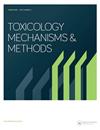Genotoxic and mutagenic effects of passive smoking and urban air pollutants in buccal mucosa cells of children enrolled in public school
IF 2.8
4区 医学
Q2 TOXICOLOGY
引用次数: 21
Abstract
Abstract Nuclear abnormalities (micronuclei and meta-nuclear changes) have been used as biomarkers to identify cell damages. As children are more vulnerable to the adverse effects of pollution when compared to adults, assessing genetic damage caused by environmental influences is of great interest. As such, the objective was to determine metanuclear (karyolysis, pycnosis, karyorrhexis, binucleated cells, chromosome bridges and micronuclei) in cells from the oral mucosa of children associated with the school environment, gender, exposure to cigarette smoke and vehicular traffic. Analyses of nuclear abnormalities were performed in exfoliated buccal cells of children from two public schools located in Dourados – MS. The data were analyzed through Kruskal–Wallis test considering a significance level of 5% (p < .05). The results showed that children exposed to cigarette smoke presented higher levels of nuclear abnormalities than children who were not usually exposed to this type of mutagenic and genotoxic agent, suggesting that such contaminants are related to clastogenic and aneugenic effects on DNA. Moreover, female children had higher amounts of nuclear abnormalities when compared to male children. With regards to the school environment, the study results indicated statistical differences in of term chromosomal abnormalities for schools A and B. Thus, it was possible to determine that children exposed to cigarette smoke are susceptible to further genetic damage than unexposed children, and female children may be more susceptible to genotoxic and mutagenic agents. This study contributes to the current knowledge on the mutagenic characteristics of human cells, supporting the adoption of preventive Public Health measures.被动吸烟和城市空气污染物对公立学校入学儿童口腔黏膜细胞的基因毒性和诱变作用
摘要核异常(微核和亚核变化)已被用作识别细胞损伤的生物标志物。与成年人相比,儿童更容易受到污染的不利影响,因此评估环境影响造成的遗传损伤非常重要。因此,目的是确定与学校环境、性别、吸烟和车辆交通有关的儿童口腔粘膜细胞中的元核(核溶解、固缩、核破裂、双核细胞、染色体桥和微核)。对位于Dourados–MS的两所公立学校的儿童的脱落颊细胞进行了核异常分析。通过Kruskal–Wallis检验分析数据,考虑到5%的显著性水平(p < .05)。结果表明,接触香烟烟雾的儿童比通常不接触这种致突变和基因毒性剂的儿童表现出更高水平的核异常,这表明这些污染物与DNA的致断裂和非整倍性影响有关。此外,与男性儿童相比,女性儿童的核异常数量更高。关于学校环境,研究结果表明,学校A和学校B的学期染色体异常存在统计学差异。因此,可以确定,接触香烟烟雾的儿童比未接触烟雾的儿童更容易受到进一步的遗传损伤,而女性儿童可能更容易受到遗传毒性和致突变剂的影响。这项研究有助于了解人类细胞的诱变特性,支持采取预防性公共卫生措施。
本文章由计算机程序翻译,如有差异,请以英文原文为准。
求助全文
约1分钟内获得全文
求助全文
来源期刊

Toxicology Mechanisms and Methods
TOXICOLOGY-
自引率
3.10%
发文量
66
期刊介绍:
Toxicology Mechanisms and Methods is a peer-reviewed journal whose aim is twofold. Firstly, the journal contains original research on subjects dealing with the mechanisms by which foreign chemicals cause toxic tissue injury. Chemical substances of interest include industrial compounds, environmental pollutants, hazardous wastes, drugs, pesticides, and chemical warfare agents. The scope of the journal spans from molecular and cellular mechanisms of action to the consideration of mechanistic evidence in establishing regulatory policy.
Secondly, the journal addresses aspects of the development, validation, and application of new and existing laboratory methods, techniques, and equipment. A variety of research methods are discussed, including:
In vivo studies with standard and alternative species
In vitro studies and alternative methodologies
Molecular, biochemical, and cellular techniques
Pharmacokinetics and pharmacodynamics
Mathematical modeling and computer programs
Forensic analyses
Risk assessment
Data collection and analysis.
 求助内容:
求助内容: 应助结果提醒方式:
应助结果提醒方式:


